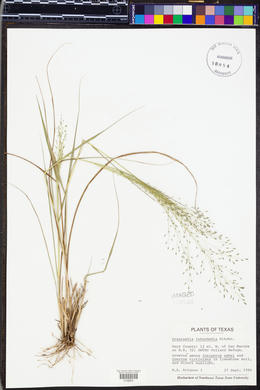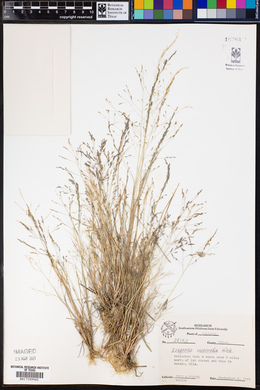Eragrostis intermedia
|
|
|
|
Family: Poaceae
Plains Love Grass, more...plains lovegrass (es: zacate volador, zacate llanero)
[Eragrostis intermedia var. appressa, moreEragrostis lugens var. major Vasey ex L.H. Dewey] |
Plants perennial; cespitose, with innovations, without rhizomes, not glandular. Culms (30)40-90(110) cm, erect, glabrous below the nodes. Sheaths sparsely pilose on the margins, apices hairy, hairs to 8 mm, not papillose-based; ligules 0.2-0.4 mm; blades (4)10-20(30) cm long, 1-3 mm wide, flat or involute, abaxial surfaces glabrous, adaxial surfaces densely hairy behind the ligules, elsewhere usually glabrous, occasionally sparsely hairy. Panicles 15-40 cm long, (8.5)15-30 cm wide, ovate, open; primary branches 4-25 cm, diverging 20-90° from the rachises, capillary; pulvini hairy or glabrous; pedicels 2-14 mm, divergent. Spikelets 3-7 mm long, 1-1.8 mm wide, narrowly lanceolate, olivaceous to purplish, with (3)5-11 florets; disarticulation acropetal, paleas persistent. Glumes lanceolate to ovate, hyaline to membranous; lower glumes 1.1-1.7 mm,narrower than the upper glumes; upper glumes 1.3-2 mm, apices acuminate to acute; lemmas 1.6-2.2 mm, ovate, membranous, hyaline near the margins, lateral veins inconspicuous, apices acute; paleas 1.4-2.1 mm, hyaline, narrower than the lemmas, apices obtuse to acute; anthers 3, 0.5-0.8 mm, purplish. Caryopses 0.5-0.9 mm, rectangular-prismatic, somewhat laterally compressed, with a well-developed adaxial groove, striate, opaque, reddish-brown. 2n = ca. 54, 60, 72, ca. 74, 80, 100, 120. Eragrostis intermedia grows in clay, sandy, and rocky soils, often in disturbed sites, at 0-1850 m. Its range extends from the United States through Mexico and Central America to South America. Eragrostis intermedia is similar to the more widespread E. lugens, but differs from that species in having wider spikelets, longer lemmas, and caryopses with a prominent adaxial groove. Dr. David Bogler, USDA NRCS PLANTS Database Perennials, Terrestrial, not aquatic, Stems nodes swollen or brittle, Stems erect or ascending, Stems geniculate, decumbent, or lax, sometimes rooting at nodes, Stems caespitose, tufted, or clustered, Stems terete, round in cross section, or polygonal, Stem internodes solid or spongy, Stem internodes hollow, Stems with inflorescence less than 1 m tall, Stems, culms, or scapes exceeding basal leaves, Leaves mostly basal, below middle of stem, Leaves mostly cauline, Leaves sheathing at base, Leaf sheath mostly open, or loose, Leaf sheath smooth, glabrous, Leaf sheath hairy at summit, throat, or collar, Leaf sheath and blade differentiated, Leaf sheath indurate basally, Leaf blades linear, Leaf blades 2-10 mm wide, Leaf blades mostly flat, Leaf blades mostly glabrous, Ligule present, Ligule a fringe of hairs, Inflorescence terminal, Inflorescence an open panicle, openly paniculate, branche s spreading, Inflorescence solitary, with 1 spike, fascicle, glomerule, head, or cluster per stem or culm, Inflorescence branches more than 10 to numerous, Flowers bisexual, Spikelets pedicellate, Spikelets laterally compressed, Spikelet less than 3 mm wide, Spikelets with 3-7 florets, Spikelets with 8-40 florets, Spikelets solitary at rachis nodes, Spikelets all alike and fertille, Spikelets bisexual, Spikelets disarticulating above the glumes, glumes persistent, Spikelets disarticulating beneath or between the florets, Rachilla or pedicel glabrous, Glumes present, empty bracts, Glumes 2 clearly present, Glumes equal or subequal, Glumes distinctly unequal, Glumes shorter than adjacent lemma, Glumes 1 nerved, Lemmas thin, chartaceous, hyaline, cartilaginous, or membranous, Lemma similar in texture to glumes, Lemma 3 nerved, Lemma glabrous, Lemma apex acute or acuminate, Lemma awnless, Lemma margins thin, lying flat, Lemma straight, Palea present, well developed, Palea membra nous, hyaline, Palea shorter than lemma, Palea 2 nerved or 2 keeled, Palea keels winged, scabrous, or ciliate, Stamens 3, Styles 2-fid, deeply 2-branched, Stigmas 2, Fruit - caryopsis, Caryopsis ellipsoid, longitudinally grooved, hilum long-linear.
FNA 2003, Gould 1980 Common Name: plains lovegrass Duration: Perennial Nativity: Native Lifeform: Graminoid General: Perennial bunchgrass, densely tufted and erect, stems 55-90 cm tall. Vegetative: Sheaths sparsely pilose on the margins, the collar pilose; ligule a dense row of white hairs 0.5 mm long; blades glabrous except for few long (8 mm) hairs above ligule; blades involute or flat, 1-3 mm wide, 10-25 cm long. Inflorescence: Panicles broadly pyramidal, open, decompound, 20-40 cm long, 15-30 cm wide, branches ascending to spreading, slender, flexuous, lower branches 10-25 cm long; axils pilose; spikelets oblong to narrowly lanceolate, compressed, grayish-green to purple tinged, 3-7 mm long, 1-2 mm wide, 5-11 flowered, disarticulating between the florets; glumes hyaline, compressed, keeled, scabrous on the keel, first glume acuminate and lanceolate, second glume acute and ovate; lemmas ovate, acute, rounded on back, loosely imbricate with inconspicuous lateral nerves; caryopsis oblong, striate. Ecology: Found on sandy and rocky slopes and plains, from 4,000-5,000 ft (1219-1524 m); flowers June-October. Distribution: Southern, central, and southwestern US, from FL, GA, and TN to AZ and CA; through MEX to Costa Rica and Guatemala. Notes: Eragrostis species have branched inflorescences (panicles); multiple, bisexual flowers (florets) per spikelet; and components of the spikelets are for the most part hairless and awnless. This species is distinguished by the diffuse, broadly pyramid-shaped, reddish inflorescence with long, delicate branches and spikelets that are solitary at the end of long pedicels. Entire panicles will break loose and roll in the wind when mature. Compare to E. lehmanniana with panicles that appear more congested because the secondary branches and pedicels are shorter; and E. curvula, with widely spaced main panicle branches but each main branch is congested with appressed branchlets and spikelets. Ethnobotany: Unknown; other species in the genus have uses. Etymology: Eragrostis is from Greek eros, love and agrostis, grass; intermedia means intermediate. Synonyms: Eragrostis lugens var. major Editor: SBuckley 2010, AHazelton 2015 |
|
|
|
























































































